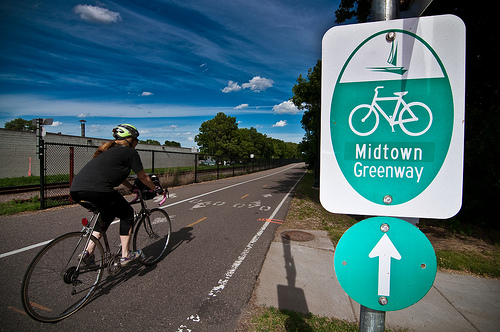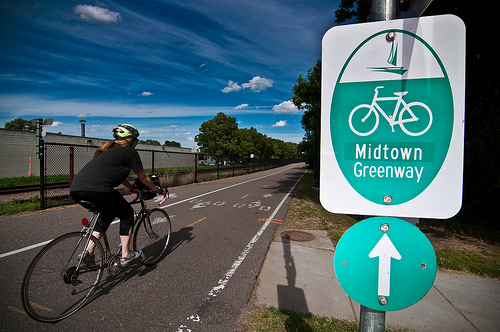 The Minneapolis Greenway.Photo: Micah TaylorElly Blue is on a monthlong Dinner & Bikes tour around the western U.S., along with Portland bike filmmaker Joe Biel and traveling vegan chef Joshua Ploeg. This is one of her thrice-weekly dispatches from the road about bicycle culture and economy. Read them all here.
The Minneapolis Greenway.Photo: Micah TaylorElly Blue is on a monthlong Dinner & Bikes tour around the western U.S., along with Portland bike filmmaker Joe Biel and traveling vegan chef Joshua Ploeg. This is one of her thrice-weekly dispatches from the road about bicycle culture and economy. Read them all here.
Minneapolis, Minn.: “Portland is just an avenue in Minneapolis” — or so says the sticker on the rear rack of the bike I brought with me on our Dinner & Bikes tour. The words are attributed to R.T. Rybak, mayor of Minneapolis, upon learning in 2010 that his city had stolen the crown of most bike friendly city in America from my hometown, Portland.
There is, in fact, a Portland Ave. in Minneapolis — and it even has a bike lane, albeit an awkward one. (Among other things, it’s on the left side of the street.) But I never understood the City of Lake’s appeal to cyclists.
Finally, this trip, I discovered what I’d been missing.
Laura Kling, the organizer of our Dinner & Bikes event here, showed me around. She runs the Grease Rag Ride & Wrench, a WTF (Women Trans Femme) night at a local bike project, and who calls herself “a radical transportation nerd.”
I met Kling at a sort of freeway interchange of bike paths — the first indication that this city takes cycling seriously. We swooped down to the first trail, which runs below ground level in what used to be the city’s rail system. Our first stop, a short way down the path, required a double-take — a bunch of cafe tables and bike racks, most in use, arranged next to the path, below street level and some distance from the nearest auto access. They belonged to a bike shop that was doing bustling business on a Sunday afternoon and, next door, a coffee shop.
Minneapolis’s Greenway bike trail system was begun in the 1990s, I was told, but has been getting a makeover and an upgrade in the last several years. Here’s a quick flick just released by StreetFilms:
I’ve never been the biggest fan of riding on bike paths, especially ones shared with people walking, but Minneapolis is doing better than most with designing these trails: Most of the paths we rode were marked with lanes for bike travel in two directions, with a separate path for walking. It’s a bold standard, but the paths were so crowded that a passing lane on each side would have been handy. (Build it and they will come!)
King then showed me where the city was rebuilding an intersection where a cyclist had recently been killed, adding a large traffic median, effectively creating one narrow, slow lane in each direction with enough room mid-crossing to shelter a veritable bike fleet. Nearby, a car-free bridge crossed a major arterial road and two sets of railroad tracks.
We paused at the top so Kling could point out the previous crossing. “It wasn’t very fun,” she said. Now, on this arcing suspension bridge, an oasis of calm above the fray, bike traffic was steady that at times it felt almost congested.
There was a dreamlike quality to the whole ride. The paths were clearly marked, the paint was new, signage was thoughtful and useful. I asked Kling if one could get around everywhere without being on the road. “You can get between parts of the city,” she said.
A few people on Nice Ride bike share bikes zoomed past. I was in awe. Kling smiled. “I’m very happy with the progress this city is making,” she said, “but I can’t say I’m satisfied.”
There were some spots that were less idyllic. In Minnehaha Falls, a gorgeous park, the bike lane narrowed, the surface was older, the middle stripe disappeared. Pedestrians, inexperienced riders, and wobbly kids strayed into our lane. Tourists tooted by on four-seat, pedal-powered contraptions. It was the same old bike path experience I learned to hate years ago.
I thought about Portland’s narrow, badly marked bike paths and all the emphasis on educating users to ride safely and “share the path.” It’s a relic of the old way of treating paths as a shared recreation system, a strip of unmarked asphalt meant for poking and wandering along, not for getting anywhere. It’s dangerous.
But the bike freeway we had been on, the new Greenway network across Minneapolis, shows what happens when you treat bike paths as a transportation system. Here, you always know where to ride, what’s coming up, and what to expect from the path and each other.
Minneapolis’s greenways need more work, more space, and more separation between bikers and walkers, but they’re a hopeful sign of what can happen when we take bicycle transportation seriously.



